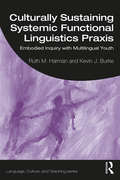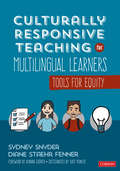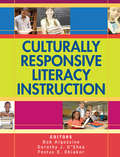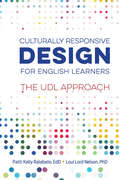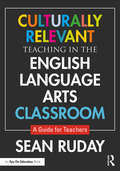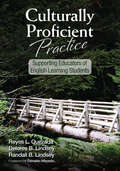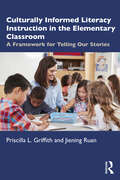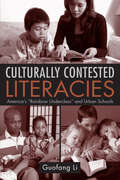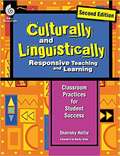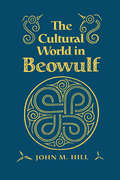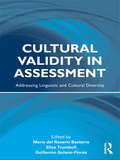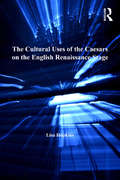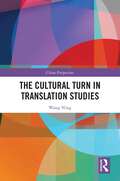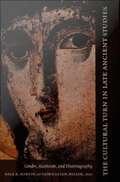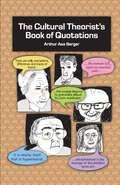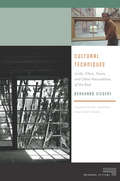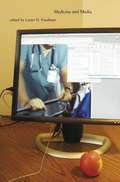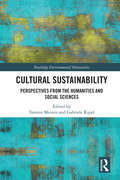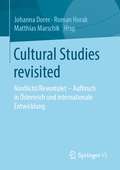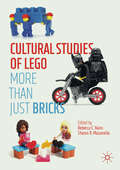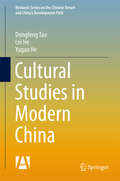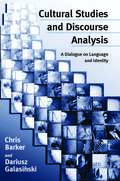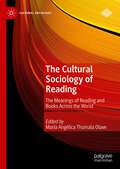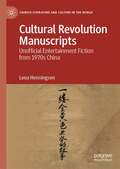- Table View
- List View
Culturally Sustaining Systemic Functional Linguistics Praxis: Embodied Inquiry with Multilingual Youth (Language, Culture, and Teaching Series)
by Kevin J. Burke Ruth M. HarmanBy introducing a framework for culturally sustaining Systemic Functional Linguistics (SFL) praxis, Harman, Burke and other contributing authors guide readers through a practical and analytic exploration of youth participatory work in classroom and community settings. Applying an SFL lens to critical literacy and schooling, this book articulates a vision for youth learning and civic engagement that focuses on the power of performance, spatial learning, community activism and student agency. The book offers a range of research-driven, multimodal resources and methods for teachers to encourage students’ meaning-making. The authors share how teachers and community activists can interact and support diverse and multilingual youth, fostering a dynamic environment that deepens inquiry of the arts and disciplinary area of knowledge. Research in this book provides a model for collaborative engagement and community partnerships, featuring the voices of students and teachers to highlight the importance of agency and action research in supporting literacy learning and transformative inquiry. Demonstrating theoretically and practically how SFL praxis can be applied broadly and deeply in the field, this book is suitable for preservice teachers, teacher educators, graduate students and scholars in bilingual and multilingual education, literacy education and language policy.
Culturally Responsive Teaching for Multilingual Learners: Tools for Equity
by Diane Staehr Fenner Sydney Cail SnyderWhat will you do to promote multilingual learners’ equity? Our nation’s moment of reckoning with the deficit view of multilingual learners has arrived. The COVID-19 pandemic has further exposed and exacerbated long-standing inequities that stand in the way of MLs’ access to effective instruction. Recent events have also caused us to reflect on our place as educators within the intersection of race and language. In this innovative book, Sydney Snyder and Diane Staehr Fenner share practical, replicable ways you can draw from students’ strengths and promote multilingual learners′ success within and beyond your own classroom walls. In this book you’ll find • Practical and printable, research-based tools that guide you on how to implement culturally responsive teaching in your context • Case studies and reflection exercises to help identify implicit bias in your work and mitigate deficit-based thinking • Authentic classroom video clips in each chapter to show you what culturally responsive teaching actually looks like in practice • Hand-drawn sketch note graphics that spotlight key concepts, reinforce central themes, and engage you with eye-catching and memorable illustrations There is no time like the present for you to reflect on your role in culturally responsive teaching and use new tools to build an even stronger school community that is inclusive of MLs. No matter your role or where you are in your journey, you can confront injustice by taking action steps to develop a climate in which all students’ backgrounds, experiences, and cultures are honored and educators, families, and communities work collaboratively to help MLs thrive. We owe it to our students.
Culturally Responsive Teaching for Multilingual Learners: Tools for Equity
by Diane Staehr Fenner Sydney Cail SnyderWhat will you do to promote multilingual learners’ equity? Our nation’s moment of reckoning with the deficit view of multilingual learners has arrived. The COVID-19 pandemic has further exposed and exacerbated long-standing inequities that stand in the way of MLs’ access to effective instruction. Recent events have also caused us to reflect on our place as educators within the intersection of race and language. In this innovative book, Sydney Snyder and Diane Staehr Fenner share practical, replicable ways you can draw from students’ strengths and promote multilingual learners′ success within and beyond your own classroom walls. In this book you’ll find • Practical and printable, research-based tools that guide you on how to implement culturally responsive teaching in your context • Case studies and reflection exercises to help identify implicit bias in your work and mitigate deficit-based thinking • Authentic classroom video clips in each chapter to show you what culturally responsive teaching actually looks like in practice • Hand-drawn sketch note graphics that spotlight key concepts, reinforce central themes, and engage you with eye-catching and memorable illustrations There is no time like the present for you to reflect on your role in culturally responsive teaching and use new tools to build an even stronger school community that is inclusive of MLs. No matter your role or where you are in your journey, you can confront injustice by taking action steps to develop a climate in which all students’ backgrounds, experiences, and cultures are honored and educators, families, and communities work collaboratively to help MLs thrive. We owe it to our students.
Culturally Responsive Literacy Instruction
by Bob Algozzine Dorothy J O'Shea Dr Festus E. ObiakorImprove reading achievement for students from diverse backgrounds with research-supported practices and culturally responsive interventions in phonemic awareness, phonics/decoding, fluency, vocabulary, and comprehension.
Culturally Responsive Design for English Learners: The UDL Approach
by Patti Kelly Ralabate Loui Lord NelsonThe cultural and linguistic diversity of students is on the rise, and educators want to know the most effective ways to teach English language learners (ELLs). Two research-based frameworks—Universal Design for Learning (UDL), which addresses the innate brain-based differences of learners, and Culturally Responsive Teaching (CRT), a pedagogy that responds to learners' cultural differences—can help. In this important new book, UDL experts and bestselling authors Patti Kelly Ralabate and Loui Lord Nelson offer a unique lesson planning process that blends UDL and CRT so that educators can proactively meet the learning needs of ELLs. This essential new resource offers scenarios, summaries, reflection questions, and classroom-based exercises to support responsive instruction. Learn to design and craft goals, methods, materials, and assessments that help ELLs optimize their educational experience.
Culturally Relevant Teaching in the English Language Arts Classroom: A Guide for Teachers
by Sean RudayThis book is a practical, research-based, classroom-ready resource for English language arts teachers interested in learning how to incorporate culturally relevant pedagogy into all aspects of their instruction, including writing, reading, and vocabulary lessons. It also provides suggestions for building an inclusive classroom environment in which all students’ backgrounds are valued. Topics covered: Writing strategies and diverse texts Dialect and student writing Applying reading strategies to texts that represent diverse backgrounds Using reading strategies in out-of-school contexts Considering students’ funds of knowledge and language awareness Connecting linguistic diversity to word-root instruction Building an inclusive classroom environment The appendix features several useful tools, including a study guide, a comprehensive list of suggested texts, recommendations for parent communication, and reproducible tools for the classroom. The study guide and reproducibles are available for free download from our website at www.routledge.com/9781138393318.
Culturally Proficient Practice: Supporting Educators of English Learning Students
by Reyes L. Quezada Delores B. Lindsey Randall B. LindseyHelp your English learning students achieve academic success! Designed to empower educators to become agents of change in their classrooms, schools, and communities, this guide introduces the principles of Cultural Proficiency and how they can help improve educators’ ability to effectively teach English language learners. This book features: <p><p> Activities that build core Cultural Proficiency skills and promote personal transformation <p> A chapter-by-chapter rubric for working effectively with English learning students <p> A conversation-starting case story featuring the River View School District <p> Strategies for using action research to improve the success of English learning students
Culturally Informed Literacy Instruction in the Elementary Classroom: A Framework for Telling Our Stories
by Priscilla L. Griffith Jiening RuanThis text introduces an original, scalable instructional framework called Telling Our Stories (TOS), an approach for supporting culturally informed literacy instruction in the elementary classroom. Connecting the theory to practice, the TOS framework centers the cultural heritage and experiences of students and offers a roadmap to scientifically and pedagogically sound instruction. Aligned with current curriculum standards, chapters feature authentic examples and case studies, reflection questions, and writing activities that will foster a culture of inclusion, community, and academic rigor. The many practical strategies promote students’ learning and appreciation of diversity through academic reading and writing as well as positive school-family and school-community relations. Readers will come away with new ideas, tools, and a thorough understanding of how to integrate culturally informed practices in ways that support the learning of all children. Accessible and comprehensive, this is an essential text for pre-service teachers in courses on ELA methods and literacy instruction, as well as practicing teachers.
Culturally Contested Literacies: America's "Rainbow Underclass" and Urban Schools
by Guofang LiCulturally Contested Literacies is a vivid ethnographic account of the everyday cross-cultural living and schooling experiences of six culturally-diverse families in urban America. Documenting the ways in which these families learn about literacies and their meanings in relation to schools, inner city environments, and other ethnic groups, Guofang Li's incisive analysis reveals the unique experiences of fractured urban America. Unlike prior research that fragments various social categories, Culturally Contested Literacies explores the rich complexity within each family as they make sense of their daily relations in terms of race, ethnicity, class, and gender. It then juxtaposes the productions of such familial relations across and within cultural groups with the context of the larger socio-political and socio-economic formations. By presenting a realistic picture of the varying ways that America’s "rainbow underclass" might encounter schooling, Li argues that urban education must be understood in relation to not only the individual’s cultural and familial milieu, but also to the interactive context between the individual and schools.
Culturally And Linguistically: Classroom Practices For Student Success (Culturally And Linguistically Responsive Teaching And Learning)
by Sharroky HollieCulturally and Linguistically Responsive Teaching and Learning is a strategy audio guide designed to help teachers learn key strategies to approach their teaching through a culturally and linguistically responsive lens; embracing and placing value on students' culture and language, allowing them to thrive in the classroom. Narrated by Dr. Sharroky Hollie, this educational resource helps teachers stay up-to-date with current research, best practices, and evidence-based teaching strategies. It provides novice and experienced educators with a pedagogical framework for implementing culturally and linguistically responsive strategies in today's diverse classrooms; addresses culture and language in five key areas: classroom management, academic literacy, academic vocabulary, academic language, and learning environment. PDF resources of the appendices from the print version are included. An ideal resource for teachers either through the school year or during the summer, but also useful for homeschooling parents looking to meet the demands of today’s educational curriculum.
Cultural World in Beowulf
by John M HillBeowulf is one of the most important poems in Old English and the first major poem in European vernacular language. It dramatizes behavior in a complex social world--a martial, aristocratic world that we often distort by imposing on it our own biases and values. In this cross-disciplinary study, John Hill looks at Beowulf from a comparative ethnological point of view. He provides a thorough examination of the socio-cultural dimensions of the text and compares the social milieu of Beowulf to that of similarly organized cultures. Through examination of historical analogs in northern Europe and France, as well as past and present societies on the Pacific rim in Southeast Asia, a complex and extended society is uncovered and an astonishingly different Beowulf is illuminated.The study is divided into five major essays: on ethnology and social drama, the temporal world, the legal world, the economy of honour, and the psychological world. Hill presents a realm where genealogies incorporate social and political statements: in this world gift giving has subtle and manipulative dimensions, both violent and peaceful exchange form a political economy, acts of revenge can be baleful or have jural force, and kinship is as much a constructible fact as a natural one. Family and kinship relations, revenge themes, heroic poetry, myth, legality, and political discussions all bring the importance of the social institutions in Beowulf to the foreground, allowing for a fuller understanding of the poems and its implications for Anglo-Saxon society.
Cultural Validity in Assessment: Addressing Linguistic and Cultural Diversity
by María Del Basterra Elise Trumbull Guillermo Solano-FloresWhat is assessment and how is it a cultural practice? How does failure to account for linguistic and cultural variation among students jeopardize assessment validity? What is required to achieve cultural validity in assessment? This resource for practicing and prospective teachers – as well as others concerned with fair and valid assessment – provides a thorough grounding in relevant theory, research, and practice. The book lays out criteria for culturally valid assessment and recommends specific strategies that teachers can use to design and implement culturally valid classroom assessments. Assessment plays a powerful role in the process of education in the US and has a disproportionately negative impact on students who do not come from mainstream, middle-class backgrounds. Given the significance of testing in education today, cultural validity in assessment is an urgent issue facing educators. This book is essential reading for addressing this important, relevant topic.
The Cultural Uses of the Caesars on the English Renaissance Stage (Studies in Performance and Early Modern Drama)
by Lisa HopkinsCaesarian power was a crucial context in the Renaissance, as rulers in Europe, Russia and Turkey all sought to appropriate Caesarian imagery and authority, but it has been surprisingly little explored in scholarship. In this study Lisa Hopkins explores the way in which the stories of the Caesars, and of the Julio-Claudians in particular, can be used to figure the stories of English rulers on the Renaissance stage. Analyzing plays by Shakespeare and a number of other playwrights of the period, she demonstrates how early modern English dramatists, using Roman modes of literary representation as cover, commented on the issues of the day and critiqued contemporary monarchs.
The Cultural Turn in Translation Studies (China Perspectives)
by Wang NingApplying the latest Western translation theories to the situation in China, this book redefines translation from an interdisciplinary and intercultural perspective, bringing intercultural semiotic translation into the sight of translation researchers. The book systematically expounds on the cultural turn in translation studies, and contributes to the escape of translation studies from the "cage of language". It focuses on discussing the deconstructive, post-modernist, and cultural translation theories that have motivated and promoted the cultural turn, especially Benjamin’s translation theory, Derrida’s deconstructive view of translation, and post-colonial translation theory. It also discusses in detail the theories of major international translation theorists, including Hillis Miller, Wolfgang Iser, Edward Said, Gayatri Spivak, Homi Bhabha, André Lefevere, Susan Bassnett, and Lawrence Venuti. These theories are mostly based on examples from Western or English-language texts, leaving a wide gap in the discourse of the field. This book seeks to fill that gap. For example, intercultural semiotic translation is defined and explained through the successful experiences of the Chinese translator Fu Lei. The role of translation during the Chinese revolution and the relocation of Chinese culture in the global cultural landscape through translation are also discussed. This book will be an essential read to students and scholars of translation studies and Chinese studies. It will also be a useful resource for translators and researchers of comparative literature and cultural studies.
The Cultural Turn in Late Ancient Studies: Gender, Asceticism, and Historiography
by Dale B. Martin Patricia Cox MillerThe essays in this provocative collection exemplify the innovations that have characterized the relatively new field of late ancient studies. Focused on civilizations clustered mainly around the Mediterranean and covering the period between roughly 100 and 700 CE, scholars in this field have brought history and cultural studies to bear on theology and religious studies. They have adopted the methods of the social sciences and humanities--particularly those of sociology, cultural anthropology, and literary criticism. By emphasizing cultural and social history and considerations of gender and sexuality, scholars of late antiquity have revealed the late ancient world as far more varied than had previously been imagined. The contributors investigate three key concerns of late ancient studies: gender, asceticism, and historiography. They consider Macrina's scar, Mary's voice, and the harlot's body as well as Augustine, Jovinian, Gregory of Nazianzus, Julian, and Ephrem the Syrian. Whether examining how animal bodies figured as a means for understanding human passion and sexuality in the monastic communities of Egypt and Palestine or meditating on the almost modern epistemological crisis faced by Theodoret in attempting to overcome the barriers between the self and the wider world, these essays highlight emerging theoretical and critical developments in the field. Contributors. Daniel Boyarin, David Brakke, Virginia Burrus, Averil Cameron, Susanna Elm, James E. Goehring, Susan Ashbrook Harvey, David G. Hunter, Blake Leyerle, Dale B. Martin, Patricia Cox Miller, Philip Rousseau, Teresa M. Shaw, Maureen A. Tilley, Dennis E. Trout, Mark Vessey
The Cultural Theorist's Book of Quotations
by Arthur Asa BergerWhere did you see it—that perfect quotation from Foucault or Kristeva to use in your upcoming keynote address? Stop the search and pick up Arthur Berger’s handy book of over 300 concise quotations from the vast literature in cultural theory. This compilation will give you just the right snappy quote to help prepare that lecture, write that paper, fill that Power Point, or drop a few bon mots at a university reception. Organized by theoretical model (semiotic, Marxist, psychoanalytic, gender, postmodernist), Berger pulls together the most succinct, meaningful passages of the key theorists of our time for those wanting to distill cultural theory to its essence.
Cultural Techniques: Grids, Filters, Doors, and Other Articulations of the Real
by Geoffrey Winthrop-Young Bernhard SiegertIn a crucial shift within posthumanistic media studies, Bernhard Siegert dissolves the concept of media into a network of operations that reproduce, displace, process, and reflect the distinctions fundamental for a given culture. Cultural Techniques aims to forget our traditional understanding of media so as to redefine the concept through something more fundamental than the empiricist study of a medium’s individual or collective uses or of its cultural semantics or aesthetics. Rather, Siegert seeks to relocate media and culture on a level where the distinctions between object and performance, matter and form, human and nonhuman, sign and channel, the symbolic and the real are still in the process of becoming. The result is to turn ontology into a domain of all that is meant in German by the word Kultur. Cultural techniques comprise not only self-referential symbolic practices like reading, writing, counting, or image-making. The analysis of artifacts as cultural techniques emphasizes their ontological status as “in-betweens,” shifting from firstorder to second-order techniques, from the technical to the artistic, from object to sign, from the natural to the cultural, from the operational to the representational. Cultural Techniques ranges from seafaring, drafting, and eating to the production of the sign-signaldistinction in old and new media, to the reproduction of anthropological difference, to the study of trompe-l’oeils, grids, registers, and doors. Throughout, Siegert addresses fundamental questions of how ontological distinctions can be replaced by chains of operations that process those alleged ontological distinctions within the ontic. Grounding posthumanist theory both historically and technically, this book opens up a crucial dialogue between new German media theory and American postcybernetic discourses.
Cultural Sutures: Medicine and Media
by Lester D. FriedmanMedicine and the media exist in a unique symbiosis. Increasingly, health-care consumers turn to media sources--from news reports to Web sites to tv shows--for information about diseases, treatments, pharmacology, and important health issues. And just as the media scour the medical terrain for news stories and plot lines, those in the health-care industry use the media to publicize legitimate stories and advance particular agendas. The essays in Cultural Sutures delineate this deeply collaborative process by scrutinizing a broad range of interconnections between medicine and the media in print journalism, advertisements, fiction films, television shows, documentaries, and computer technology. In this volume, scholars of cinema studies, philosophy, English, sociology, health-care education, women's studies, bioethics, and other fields demonstrate how the world of medicine engages and permeates the media that surround us. Whether examining the press coverage of the Jack Kevorkian-euthanasia controversy; pondering questions about accessibility, accountability, and professionalism raised by such films as Awakenings, The Doctor, and Lorenzo's Oil; analyzing the depiction of doctors, patients, and medicine on E. R. and Chicago Hope; or considering the ways in which digital technologies have redefined the medical body, these essays are consistently illuminating and provocative. Contributors. Arthur Caplan, Tod Chambers, Stephanie Clark-Brown, Marc R. Cohen, Kelly A. Cole, Lucy Fischer, Lester D. Friedman, Joy V. Fuqua, Sander L. Gilman, Norbert Goldfield, Joel Howell, Therese Jones, Timothy Lenoir, Gregory Makoul, Marilyn Chandler McEntyre, Faith McLellan, Jonathan M. Metzl, Christie Milliken, Martin F. Norden, Kirsten Ostherr, Limor Peer, Audrey Shafer, Joseph Turow, Greg VandeKieft, Otto F. Wahl
Cultural Sustainability: Perspectives from the Humanities and Social Sciences (Routledge Environmental Humanities)
by Torsten Meireis Gabriele RipplIf the political and social benchmarks of sustainability and sustainable development are to be met, ignoring the role of the humanities and social, cultural and ethical values is highly problematic. People’s worldviews, beliefs and principles have an immediate impact on how they act and should be studied as cultural dimensions of sustainability. Collating contributions from internationally renowned theoreticians of culture and leading researchers working in the humanities and social sciences, this volume presents an in-depth, interdisciplinary discussion of the concept of cultural sustainability and the public visibility of such research. Beginning with a discussion of the concept of cultural sustainability, it goes on to explore its interaction with philosophy, theology, sociology, economics, arts and literature. In doing so, the book develops a much needed concept of ‘culture’ that can be adapted to various disciplines and applied to research on sustainability. Addressing an important gap in sustainability research, this book will be of great interest to academics and students of sustainability and sustainable development, as well as those studying sustainability within the humanities and social sciences, such as cultural studies, ethics, theology, sociology, literature and history.
Cultural Studies revisited: Nordlicht/Revontulet - Aufbruch in Österreich und internationale Entwicklung
by Johanna Dorer Roman Horak Matthias MarschikDieses Buch präsentiert Cultural Studies, beginnend mit der österreichischen Aufbruchsstimmung und begleitet von internationalen Stimmen der Tagungsteilnehmer*innen in Tampere und Birmingham. Es zeigt die vielfältige Forschungswelt der Cultural Studies bis heute und schlägt Brücken in die Zukunft.Cultural Studies waren ein Versprechen und vielleicht auch eine wissenschaftliche Verheißung. Im wahrsten Wortsinn erschienen sie, als in Finnland die ersten internationalen Tagungen stattfanden, wie ein Nordlicht am Horizont: Revontulet. Die Crossroads-Konferenzen in Tampere (1996, 1998) und Birmingham (2000) waren für Wissenschaftler*innen der Beginn eines interventionistischen Wissenschaftsprojekts, das in Wien seinen Ursprung im Institut für Kulturstudien (IKUS) hatte.
Cultural Studies of LEGO: More Than Just Bricks
by Rebecca C. Hains Sharon R. MazzarellaThis collection examines LEGO from an array of critical and cultural studies approaches, foregrounding the world-renowned brand's ideological power and influence. Given LEGO’s status as the world’s largest toy manufacturer and a transnational multimedia conglomerate, Cultural Studies of Lego: More Than Just Bricks considers LEGO media's cultural messages; creativity with and within LEGO artifacts; and diversity within the franchise, including gender and race representation. The chapters’ in-depth analyses of topics including LEGO films, marketing tactics, play sets, novelizations, and fans offer compelling insights relevant to those interested in the LEGO brand and broader trends in the children’s popular culture market alike.
Cultural Studies in Modern China (Research Series on the Chinese Dream and China’s Development Path)
by Dongfeng Tao Lei He Yugao HeAs the first book to introduce and analyze cultural studies in contemporary China, this volume is an important resource for Western scholars wishing to understand the rise and development of cultural studies in China. Organized according to subject, it includes extensive material examining the relationships between culture and politics, as well as culture and institutions in contemporary China. Further, it discusses the development of cultural debates.
Cultural Studies and Discourse Analysis: A Dialogue on Language and Identity (Cultural Studies)
by Chris Barker Dariusz Galasi SkiThis novel and important book brings together insights from cultural studies and critical discourse analysis to examine the fruitful links between the two. Cultural Studies and Discourse Analysis shows that critical discourse analysis is able to provide the analytic context, skills and tools by which we can study how language constructs, constitutes and shapes the social world and demonstrates in detail how the methodological approach of critical discourse analysis can enhance cultural studies. In a richly argued discussion, the authors show how marrying the methodology of critical discourse analysis with cultural studies enlarges our understanding of gender and ethnicity.
The Cultural Sociology of Reading: The Meanings of Reading and Books Across the World (Cultural Sociology)
by María Angélica Thumala OlaveThis book showcases recent work about reading and books in sociology and the humanities across the globe. From different standpoints and within the broad perspectives within the cultural sociology of reading, the eighteen chapters examine a range of reading practices, genres, types of texts, and reading spaces. They cover the Anglophone area of the United States, the United Kingdom and Australia; the transnational, multilingual space constituted by the readership of the Colombian novel One Hundred Years of Solitude; nineteenth-century Chile; twentieth-century Czech Republic; twentieth century Swahili readings in East Africa; contemporary Iran; and China during the cultural revolution and the post-Mao period. The chapters contribute to current debates about the valuation of literature and the role of cultural intermediaries; the iconic properties of textual objects and of the practice of reading itself; how reading supports personal, social and political reflection; bookstores as spaces for sociability and the interplay of high and commercial cultures; the political uses of reading for nation-building and propaganda, and the dangers and gratifications of reading under repression. In line with the cultural sociology of reading’s focus on meaning, materiality and emotion, this book explores the existential, ethical and political consequences of reading in specific locations and historical moments.
Cultural Revolution Manuscripts: Unofficial Entertainment Fiction from 1970s China (Chinese Literature and Culture in the World)
by Lena HenningsenThis book investigates handwritten entertainment fiction (shouchaoben wenxue) which circulated clandestinely during the Chinese Cultural Revolution. Lena Henningsen’s analyses of exemplary stories and their variation across different manuscript copies brings to light the creativity of these readers-turned-copyists. Through copying, readers modified the stories and became secondary authors who reflected on the realities of the Cultural Revolution. Through an enquiry into actual reading practices as mapped in autobiographical accounts and into intertextual references within the stories, the book also positions manuscript fiction within the larger reading cosmos of the long 1970s. Henningsen analyzes the production, circulation and consumption of these texts, considering continuities across the alleged divide of the end of the Mao-era and the beginning of the reform period. The book further reveals how these texts achieved fruitful afterlives as re-published bestsellers or as adaptations into comic books or movies, continuing to shape the minds of their audience and the imaginations of the past.Chapter 5 is available open access under a Creative Commons Attribution 4.0 International License via link.springer.com.
